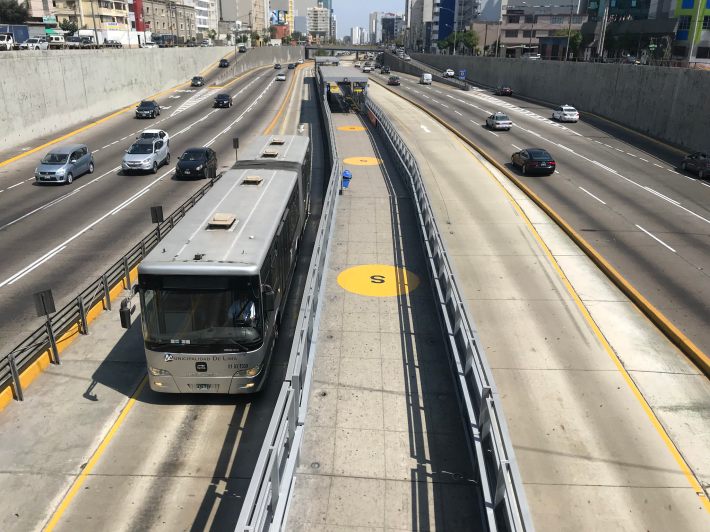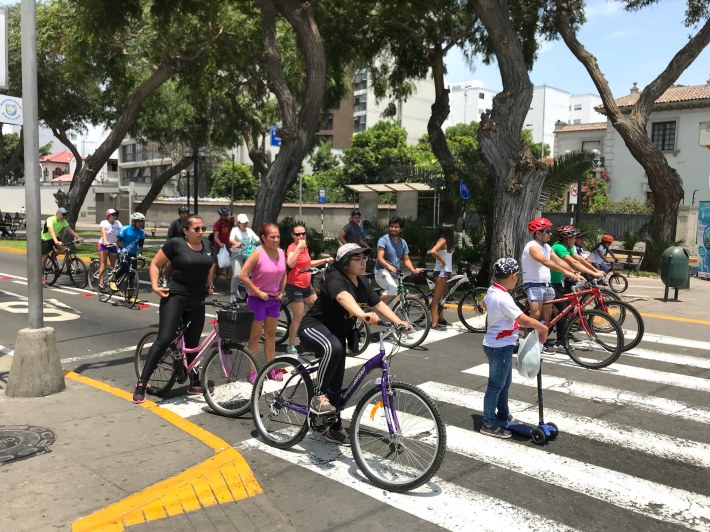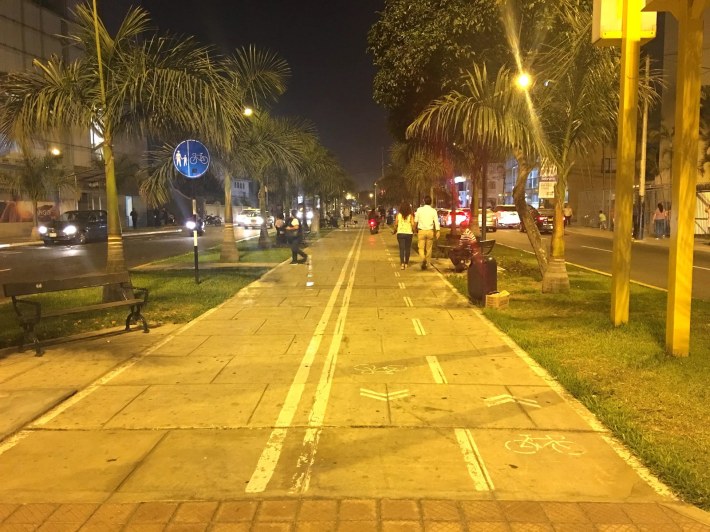[Streetsblog Chicago editor John Greenfield publishes a weekly transportation column in the Chicago Reader. We syndicate the column on Streetsblog Chicago after it comes out online. Read a different version of this article, focusing on Lima's boulevard bike paths, on the Reader website.]
Compared to other Latin American capitals I’ve visited in recent years, including Mexico City and Bogotá, Colombia, Lima, Peru, doesn’t offer a wealth of transportation best practice for Chicago.
That’s not to say that this city of roughly 10 million residents isn’t an excellent and underrated destination in its own right. When I visited earlier this month, I was impressed by Lima’s dramatic cliffside setting over the Pacific Ocean, with lush coastal parks studded with palm trees, offering recreation for strollers, cyclists, surfers, and paragliders alike. Cultural attractions include the Museo Larco, with an exquisite collection of Inca gold artifacts and ceramics, and a separate gallery of hilarious ancient erotic pottery. I also dug the lovely Parque John F. Kennedy in the hip Miraflores neighborhood, which hosts free multigenerational salsa dancing sessions and a colony of friendly feral cats, well-cared-for by local volunteers. And as the culinary capital of South America, Lima offers a wealth of gustatory delights, from super-fresh, bracingly acidic ceviche to savory anticucho beef heart skewers, expertly prepared by old ladies on streetside grills.
But it has to be noted that traveling across this car-choked metropolis can be a frustrating experience. Unlike Mexico City and Bogotá, Lima lacks a robust mass transit system, and while stewing in traffic during taxi and Uber rides, I longed for the ability to hop on an el train or subway. Public transportation is largely provided by a chaotic patchwork of privately run buses and minivans.'

However, Lima’s transportation mix improved a bit in 2010 with the launch of El Metropolitano, a 21-mile north-south bus rapid transit route that serves as a spinal cord for the city. With car-free lanes and prepaid, multi-door bus boarding, the buses travel at subway-like speeds, although I’m told there’s brutal crowding during rush hours, which suggests that the city needs to build more lines. Still, El Metropolitano’s popularity is still more evidence that Chicago should follow through with the CTA’s plan for robust BRT on Ashland Avenue, which was shelved several years ago due to a stiff backlash from merchants and residents, who worried that taking away street space from drivers would create a traffic nightmare.
Another area where Lima offers a few transportation practices that Chicago should emulate is cycling. In February the Peruvian capital hosted the World Bicycle Forum, attracting advocates from all over Latin America, North America, and Europe for several days of rides, parties, and discussions of how biking can be used to promote urban mobility, public health, and social justice.
While I wasn’t able to attend, Oboi Reed from the Chicago-based transportation equity nonprofit Equiticity, which has been fighting the Chicago Police Department’s practice of concentrating bike tickets in African-American neighborhoods, gave a presentation punctuated by a booming hip-hop soundtrack. “We’re building a global movement of black, brown, and indigenous people riding biking bikes to improve our neighborhoods, our cities, and the world,” he declared. The crowd, made up largely of cycling advocates of color, erupted in cheers.
Reed later told me that while mainstream U.S. bike boosters tend to look to northern European cities like Amsterdam and Copenhagen as role models, he sees the Latin-American style of cycling promotion, which views biking as a vehicle to address socio-economic problems, not just a transportation mode, as more relevant to people in low-to-moderate-income communities of color in Chicago and around the U.S. He added that Equiticity is already organizing South American transportation study tours for Chicago stakeholders through contacts he made at the forum, starting with a trip to Brazil this June.

One of the Latin-American cycling promotion strategies that Reed cited is the Ciclovía or “cycleway” event, which started in Bogotá decades ago and has since spread to cities all over the world. During Ciclovías, streets are closed to cars and opened for walking, biking, skating, and other forms of healthy recreation like Zumba and breakdancing, often on a weekly basis. The events also promote social integration, since the car-free streets encourage people of different classes and races to visit each other’s neighborhoods.
Between 2008 and 2013, Chicago’s Active Transportation Alliance tried to establish a regularly occurring Ciclovía in Chicago called Open Streets. But the nonprofit ultimately gave up on the effort due to a lack of organizational and financial help from City Hall.
Lima’s Ciclovía takes place every Sunday morning on several miles of Avenida Arequipa, a boulevard connecting Miraflores with the historic city center. When I participated during my visit, I was struck by the event’s joyful vibe, with Limeños of all ages enjoying the Tropic of Capricorn sunshine on bike, foot, and scooter.

That’s not to say that Lima is a pedaler’s paradise, as local bike advocates "Enzo Polo" (not his real name -- he said he prefers anonymity on the Internet) and Hugo Campodónico were quick to acknowledge when I met up with them at the bike-themed café Milimetrica in Miraflores. Their organization Actibícimo, helped stage the bicycle forum and is now pushing the city to triple the amount of bikeways, currently about 125 miles (Our city presently has 294 miles, according to the Chicago Department of Transportation.)
Polo noted that many Lima drivers aren’t used to sharing the streets with bikes, and right of way at intersections often amounts to a game of chicken. “So you have to be aware on your bike and you can’t be lazy,” he said. “You have to be [snaps fingers twice] vivo (‘alive.’)” Campodónico added that while many neighborhoods have bike lanes and paths, there are big gaps in the bikeway network, just like in Chicago.
But one Lima cycling strategy that Reed and I would both love to see copied in our city is the extensive system of boulevard bike paths. Particularly in cycle-friendly neighborhoods like Miraflores and toney San Isidro, the grassy medians of large streets like Avenida Arequipa often have cycling and walking routes running through the center. These trails link up nicely with Lima’s popular cliffside bike path, which is analogous to Chicago’s Lakefront Trail.

Reed called riding on the Arequipa bike path “awesome” and said he can imagine our taking a similar approach in the medians of Stony Island Avenue, which would make it easier to pedal to the upcoming Obama Presidential Center from the far south side. Watch a video Reed took of riding on Arequipa here. The strategy could also work nicely on many of the grassy strips within Chicago’s extensive boulevard system.
Sure, there would be some traffic engineering challenges to work out. For example, when the Lima boulevards cross other major streets, cyclists are sometimes required to make three street crossings to get to the next median path, which is annoying.
But this Peruvian approach could be a relatively simple way to greatly increase the number of family-friendly bikeways in our city, without the political challenges that come with taking street space away from drivers. Come on, CDOT, how about taking this idea for a spin?






